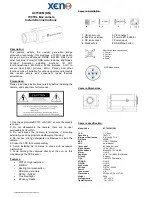
136
VQT3G90
VQT3G90
137
Q&A
Troubleshooting
(Continued)
Recording (continued)
Brightness or coloring of recorded picture different from real life.
●
Taking pictures under fluorescent lighting may require a faster shutter speed and result in slightly
changed brightness or coloring, but this is not a fault.
Reddish horizontal streaks appear on the LCD monitor during recording.
●
This is characteristic of MOS sensors which serve as the camera’s pickup sensors. It appears when
the subject has a bright part. Some unevenness may occur in the surrounding areas, but this is not
a malfunction. It is recorded in motion pictures but is not recorded on still pictures.
●
It is recommended that you take pictures while taking care not to expose the screen to sunlight or
any other source of strong light.
Motion picture recording stops midway.
●
An AVCHD motion picture can be recorded continuously for up to 29 minutes 59 seconds when
[GFS] or [FSH] is set.
●
If [Rec Quality] is set to [GFS] or [FSH], and if the surrounding temperature is high, or motion picture
is recorded continuously,
is displayed, and the recording may be stopped halfway through.
●
With some cards, access display may appear briefly after recording, and recording may end midway.
●
If recording stops even when using a card of the recommended speed class (
→
14), the data writing
speed has dropped. If this happens, we recommend backing up the data on the memory card and
formatting it (
→
48).
The subject cannot be locked. (AF track fails)
●
If the color of the subject is similar to that of its background, AF Tracking may not function. Set the
AF area to those colors specific to the subject by aligning that area with the AF area.
LCD monitor
LCD monitor dims during motion picture recording.
●
LCD monitor may dim if continuing motion picture recording for long periods.
Brightness is unstable.
●
Aperture value is set while shutter button is pressed halfway.
(Does not affect recorded picture.) This symptom may also occur when the brightness changes
because the zoom is operated or the camera is moved. This is the automatic aperture operation of
the camera and is not a malfunction.
Monitor flickers indoors.
●
Monitor may flicker after turning on (prevents influence from fluorescent lighting).
Monitor is too bright/too dark.
●
[LCD Mode] is activated (
→
43).
Black/blue/red/green dots or interference appears. Monitor looks distorted when
touched.
●
This is not a fault, and will not be recorded on the actual pictures.
Flash
No flash emitted.
●
Flash set to
[Forced Flash Off] (
→
52).
●
Flash cannot be emitted in the [Scenery], [Panorama Assist], [Night Scenery], [Handheld Night
Shot], [Sunset], [Starry Sky], [Fireworks], [Aerial Photo] and [High Speed Movie] Scene Modes, or
when using [Auto Bracket] or [Burst].
Multiple flashes are emitted.
●
Red-eye reduction is active (
→
52). (Flashes twice to prevent eyes appearing red.)
●
The Scene Mode is set to [Flash Burst].
Playback
Pictures have been rotated.
●
[Rotate Disp.] is set to
.
Cannot view pictures. There are no recorded pictures.
●
REC/PLAY switch is not set to
(play).
●
No pictures in built-in memory or card (pictures played from card if inserted, from built-in memory if
not).
●
Has the file name of the picture been changed on a computer? If so, it cannot be played back on the
camera.
●
The Playback Mode has been changed.
→
Set Playback Mode to [Normal Play] (
→
102).
Folder/file number displayed as [-]. Picture is black.
●
Picture edited on computer or taken on different device.
●
Battery removed immediately after picture taken, or picture taken with low battery.
→
Use [Format] to delete (
→
48).
Incorrect date displayed in Calendar Playback.
●
Picture edited on computer or taken on different device.
●
[Clock Set] is incorrect (
→
18).
(Incorrect date may be displayed in Calendar Playback on pictures copied to computer and then
back to camera, if computer and camera dates differ.)
White round spots like soap bubbles appear on the recorded picture.
●
If you take a picture with the flash in a dark place or indoors, white round spots may
appear on the picture caused by the flash reflecting particles of dust in the air. This is
not a fault. A characteristic of this is that the number of round spots and their position
differ in every picture.
[Thumbnail is displayed] is shown on the screen.
●
The pictures may have been recorded on another device. If so, they may be displayed with poor
picture quality.












































